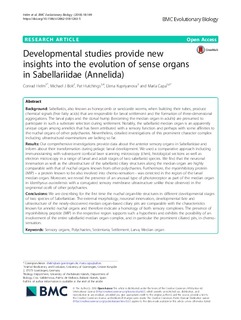| dc.contributor.author | Helm, Conrad | |
| dc.contributor.author | Bok, Michael J | |
| dc.contributor.author | Hutchings, Pat | |
| dc.contributor.author | Kupriyanova, Elena | |
| dc.contributor.author | Capa, Maria | |
| dc.date.accessioned | 2019-03-22T12:37:32Z | |
| dc.date.available | 2019-03-22T12:37:32Z | |
| dc.date.created | 2018-11-30T10:18:49Z | |
| dc.date.issued | 2018 | |
| dc.identifier.citation | BMC Evolutionary Biology. 2018, 18 (149), . | nb_NO |
| dc.identifier.issn | 1471-2148 | |
| dc.identifier.uri | http://hdl.handle.net/11250/2591316 | |
| dc.description.abstract | Background
Sabellarids, also known as honeycomb or sandcastle worms, when building their tubes, produce chemical signals (free fatty acids) that are responsible for larval settlement and the formation of three-dimensional aggregations. The larval palps and the dorsal hump (becoming the median organ in adults) are presumed to participate in such a substrate selection during settlement. Notably, the sabellariid median organ is an apparently unique organ among annelids that has been attributed with a sensory function and perhaps with some affinities to the nuchal organs of other polychaetes. Nevertheless, detailed investigations of this prominent character complex including ultrastructural examinations are lacking so far.
Results
Our comprehensive investigations provide data about the anterior sensory organs in Sabellariidae and inform about their transformation during pelagic larval development. We used a comparative approach including immunostaining with subsequent confocal laser scanning microscopy (clsm), histological sections as well as electron microscopy in a range of larval and adult stages of two sabellariid species. We find that the neuronal innervation as well as the ultrastructure of the sabellariid ciliary structures along the median organ are highly comparable with that of nuchal organs known from other polychaetes. Furthermore, the myoinhibitory protein (MIP) – a protein known to be also involved into chemo-sensation - was detected in the region of the larval median organ. Moreover, we reveal the presence of an unusual type of photoreceptor as part of the median organ in Idanthyrsus australiensis with a corrugated sensory membrane ultrastructure unlike those observed in the segmental ocelli of other polychaetes.
Conclusions
We are describing for the first time the nuchal organ-like structures in different developmental stages of two species of Sabellariidae. The external morphology, neuronal innervation, developmental fate and ultrastructure of the newly-discovered median organ-based ciliary pits are comparable with the characteristics known for annelid nuchal organs and therefore indicate a homology of both sensory complexes. The presence of myoinhibitory peptide (MIP) in the respective region supports such a hypothesis and exhibits the possibility of an involvement of the entire sabellariid median organ complex, and in particular the prominent ciliated pits, in chemo-sensation. | nb_NO |
| dc.language.iso | eng | nb_NO |
| dc.publisher | BMC (part of Springer Nature) | nb_NO |
| dc.rights | Navngivelse 4.0 Internasjonal | * |
| dc.rights.uri | http://creativecommons.org/licenses/by/4.0/deed.no | * |
| dc.title | Developmental studies provide new insights into the evolution of sense organs in Sabellariidae (Annelida) | nb_NO |
| dc.type | Journal article | nb_NO |
| dc.type | Peer reviewed | nb_NO |
| dc.description.version | publishedVersion | nb_NO |
| dc.source.pagenumber | 13 | nb_NO |
| dc.source.volume | 18 | nb_NO |
| dc.source.journal | BMC Evolutionary Biology | nb_NO |
| dc.source.issue | 149 | nb_NO |
| dc.identifier.doi | 10.1186/s12862-018-1263-5 | |
| dc.identifier.cristin | 1637348 | |
| dc.description.localcode | © The Author(s). 2018 Open Access This article is distributed under the terms of the Creative Commons Attribution 4.0 International License (http://creativecommons.org/licenses/by/4.0/) | nb_NO |
| cristin.unitcode | 194,31,10,0 | |
| cristin.unitname | Institutt for naturhistorie | |
| cristin.ispublished | true | |
| cristin.fulltext | original | |
| cristin.qualitycode | 2 | |

